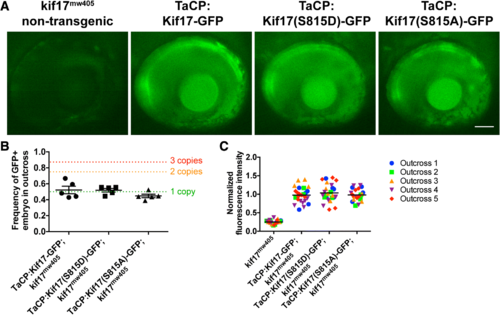Fig. 3
- ID
- ZDB-FIG-190201-37
- Publication
- Lewis et al., 2018 - Kif17 phosphorylation regulates photoreceptor outer segment turnover
- Other Figures
- All Figure Page
- Back to All Figure Page
|
Establishment of stable lines of Kif17 transgenic zebrafish. a The three stable transgenic lines of zebrafish were outcrossed to kif17mw405 zebrafish. At 4dpf, zebrafish embryos were screened with epifluorescence to ensure virtually identical levels of expression among the three lines: Kif17-GFP, Kif17(S815D)-GFP, and Kif17(S815A)-GFP. Of note, the bright band of fluorescence at the back of the eye corresponds to the cone photoreceptors that are specifically expressing each of the three transgenes through TaCP, the cone-specific promoter. Additionally, each of the transgenic zebrafish have a significantly higher level of fluorescence than the autofluorescence observed in non-transgenic kif17mw405 zebrafish. For any experiment using the stable transgenic lines of zebrafish, screening is performed to verify the virtually identical level of expression. Scale bar is 50 μm. b For generation of the three stable transgenic lines of zebrafish, several generations of outcrossing to kif17mw405 zebrafish were performed to ensure there was only a single genomic insert of each transgene. Following independent assortment and Mendelian inheritance, the frequency of transgene inheritance in an outcross can be used to determine the insert or copy number of each transgene according to: , where n = copy number. Thus, a single insert would be inherited 50% of the time (green dotted line), two inserts would be 75% of the time (orange dotted line), and three inserts would be 87.5% of the time (red dotted line). Of note, the frequency of transgene inheritance for each of the three stable lines, TaCP:Kif17-GFP (n = 5 outcrosses, 203 total embryos screened), TaCP:Kif17(S815D)-GFP (n = 5 outcrosses, 231 embryos), and TaCP:Kif17(S815A)-GFP (n = 5 outcrosses, 279 embryos), is ~ 50%, suggesting that each of the stable transgenic lines contain only a single insert. One-way ANOVA was performed to show that there is no statistical significant difference among inheritance of each transgene (p = 0.2163). One sample t-test was performed to show that frequencies of TaCP:Kif17-GFP (p = 0.6579), TaCP:Kif17(S815D)-GFP (p = 0.4510), and TaCP:Kif17(S815A)-GFP (p = 0.0706) inheritance were not significantly different from 50%. c In addition to ensuring each of the stable lines was a single insert, we selected for stable transgenic lines that had a virtually identical level of fluorescence among them. The fluorescence intensity of each of the transgenes as well as a non-transgenic kif17mw405 zebrafish (n = 5 outcrosses, 25 total embryos each) was measured and normalized to the average fluorescence intensity of TaCP:Kif17-GFP. One-way ANOVA was performed to show that there is a statistical significant difference in fluorescence levels among the transgenic fish and the non-transgenic fish (p < 0.0001). A post-hoc Bonferroni analysis to compare groups was performed to show no significant differences between any of the transgenic fish (p > 0.9999), but a significant increase in fluorescence of the transgenic fish compared to the autofluorescence of a non-transgenic fish (p < 0.0001, ****) |

